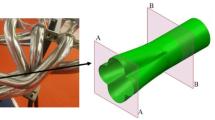Abstract
Tube hydroforming technology (THF) has been extensively applied to auto-body structural members such as the engine cradle and side member in order to meet the urgent need for vehicle weight and cost reduction as well as high quality for collision accidents. In this paper, the mechanical properties for hydroformed tubes with various bulging strians under the plane strain mode are experimentally investigated. Axial compression tests for hydroformed tubes are performed to investigate the collapse load and collapse absorption capacity through the collapse load-displacement curves. Moreover, the collapse absorption capacities are compared and discussed among as-received, hydroformed, and press formed tubes. Results demonstrate that the hydroformed tubes show higher collapse absorption capability in comparison with the as-received tube and the press formed tube because of its high yield strength due to strain hardening.
Similar content being viewed by others
References
S. Fuchizawa and H. Takeyama,J. Jpn. Soc. Precision Eng. 45, 106 (1979).
M. Koc and T. Altan,J. Mat. Proc. Tech. 108, 384 (2001).
F. Dohmann and C. Hartl,lJ. Mat. Proc. Tech. 71, 174 (1997).
Y. S. Kim, H. S. Cho, C. D. Park and W. J. Choi,J. Kor. Soc. Tech. Plasticity 9, 604 (2000).
S. T. Kim, S. W. Im, T. G. Lee, and Y. S. Kim,J. Kor. Soc. Tech. Plasticity 9, 35 (2000).
N. Asnafi and A. Skogsgardh,Mater. Sci. Eng. A 279, 95 (2000).
R. H. Wagoner and J. V. Laukonis,Metall. Trans. A 14, 1487 (1983).
J. V. hLaukonis and R. H. Wagoner,Metall. Trans. A 16, 421 (1985).
A. B. Doucet and R. H. Wagoner,Metall. Trans. A 20, 1483 (1989).
S. R. Reid,Int. J. Mech. Sci. 35, 1035 (1993).
T. Wierzbicki and W. Abramowicz,J. Appl. Mech. 50, 727 (1983).
F. Bleich,Buckling Strength of Metal Structures, McGraw-Hill Book Co., New York (1952).
J. M. Alexander,Quart. J. Mech. Appl. Math. 13, 10 (1960).
W. Abramowiez and N. Jones,Int. J. Impact Eng. 4, 243 (1986).
C. H. Jeong,Master Thesis, Yonsei University, Seoul, Korea (1998)
C. W. Kim, B. K. Han and C. J. Won,J. Kor. Soc. Auto. Eng. 6, 119 (1998).
S. R. Guillow, G. Lu, and R. H. Grzebieta,Int. J. Mech. Sci. 43, 2103 (2001).
Author information
Authors and Affiliations
Rights and permissions
About this article
Cite this article
Kim, YS., Lee, YM., Kim, C. et al. Collapse characteristics of hydroformed tubes. Met. Mater. Int. 8, 359–365 (2002). https://doi.org/10.1007/BF03186108
Issue Date:
DOI: https://doi.org/10.1007/BF03186108



